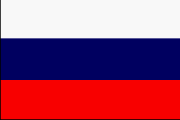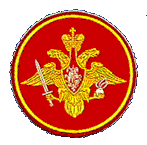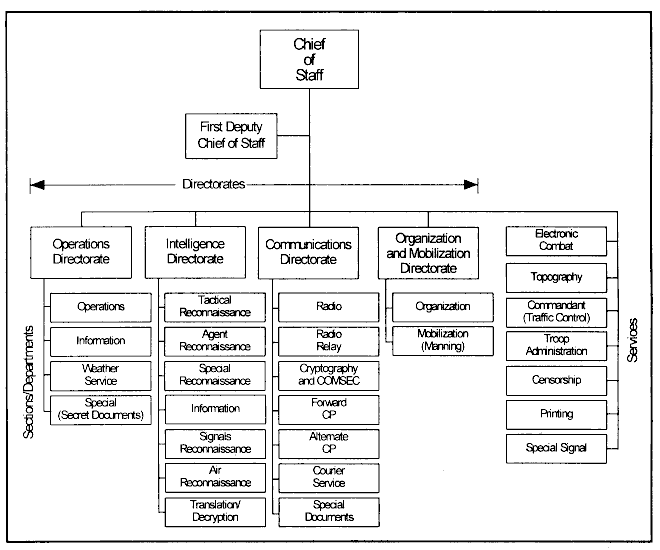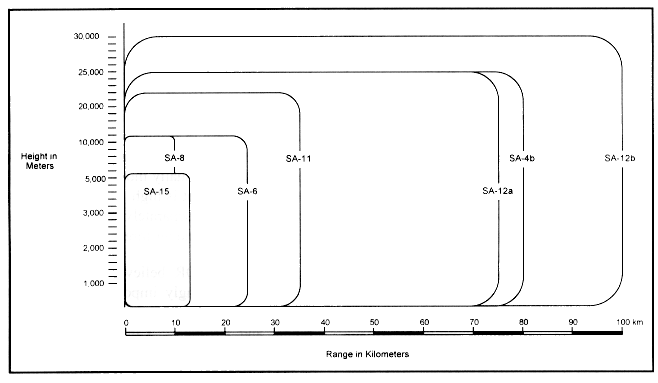






The ground forces are organized into six [previously eight] military districts, one independent army, and two groups of forces. Although the districts are ground forces commands, they may include forces from the other services, in which case they also serve as regional commands. In February 1996, four of Russia's eight independent airborne brigades were placed under ground forces command, with one each going to the North Caucasus, Siberian, Transbaikal, and Far Eastern districts. At the same time, two of five airborne divisions, stationed at Pskov and Novorossiysk, were assigned for special joint operations to the Northern and Siberian districts, respectively. These shifts, which outside observers interpreted as the end of plans to form a mobile force for rapid insertion in trouble areas, reflected a shortage of the airlift capacity needed to support independent operations by such troops, as well as a possible fear of coup activity in independent elite military units.
The army group, army, or corps commander has chiefs of branches subordinate to him. They normally report to him through the chief of staff. The commander of missile troops and artillery (CMTA) at the operational level is a commander (rather than chief). There is also a commander of air defense. There are chiefs of engineer, chemical, and signal troops and a chief of the personnel directorate. Each of these individuals has his own staff.
Combat elements of the Ground Forces were organized into combined arms and tank armies. A combined arms army included three motorized rifle divisions and a tank division. A tank army had three tank divisions and one motorized rifle division. In the late 1980s, the Ground Forces began to field corps that were more than twice the size of a single division. At every level from brigade upward, chiefs of branches augment the primary staff, conforming to the needs of the level of command. These officers bring specialized knowledge and skills to the control of various elements of the combined arms. Although the chiefs perform as an element of the commanderís staff in advising him on the use of forces in their branch of troops or services, in many cases they are also commanders. They are responsible for artillery, engineer, or air defense units readiness and performance. Like the primary staff, the chiefs continuously interact with the corresponding chiefs of branches at both higher and lower levels of command. Although directly subordinate to the commander of their own force, chiefs of branches also receive and issue directives and instructions through a chain of special subordination within their branch. For example, because of the complex coordination required to integrate army group and army fire support planning in an offensive, the army CMTA can be specially subordinate to the army group CMTA. This special subordination serves as a high-speed channel for guidance, control, and coordination concerning the allocation and use of missile and artillery assets, while preserving the authority and responsibility of the army group and army commanders.
The title Guard is the honor bestowed on units for heroism demonstrated in battles. The Guard was born on 18 September 1941 when divisions ## 100, 127, 153 were renamed into the First, the Second and the Third Guard Divisions respectively. In many cases the unit simultaneously received a name usually related to place of the heaviest battles for which it was honored, like Kantemirovskaya Guard Division [4th Guards Tank Division], Tamanskaya [2nd Guards Motorized Rifle Division] and others.
During the Soviet era a motorized rifle division had 12,000 soldiers organized into three motorized rifle regiments, a tank regiment, an artillery regiment, an air defense regiment, surface-to-surface missile and antitank battalions, and supporting chemical, engineer, signal, reconnaissance, and rear services companies. A typical tank division had 10,000 soldiers organized into three tank regiments and one motorized rifle regiment. In 1989 the Ground Forces also included eight brigades of air assault, or air-mobile, units that conducted helicopter landing operations.
Compared to Russian forces, US Army divisions have more infantry troops and larger logistic support, but fewer armored vehicles and artillery tubes. Russian forces are intended primarily for local regional operations and thus have fewer mobility assets and projection capabilities than possessed by the United States. The US military posture thus can deploy and operate at long distances, but the Russian military posture cannot do so to nearly such a degree.
In the early 1980s, out of a total of 194 active tank, motorized rifle and airborne divisions in the Soviet force, 65 were located in the western USSR, 30 in Eastern Europe and an additional 20 in the Transcaucasus and North Caucasus Military Districts (MDs). All these divisions would were available for offensive operations against NATO. In addition to these forces, 17 low-strength divisions, centrally located in the USSR, constituted the Strategic Reserves. For operation in the Southern Theater the Soviets had in place six divisions in the Turkestan MD and four engaged in combat operations in Afghanistan. These forces could be reinforced by the 20 divisions from the Caucasus MDs if they were not engaged against NATO. Soviet forces for operations in the Far East were composed of 52 tank and motorized rifle divisions. The six Warsaw Pact Allies of the Soviet Union had a total of 55 active divisions, which, collectively with Soviet divisions, amounted to 249 combat divisions.
Many of these divisions, most notably those in the interior of the USSR, were at low stages of readiness. The Soviets also maintained 17 mobilization bases, predominantly in the western USSR, that could form additional combat divisions. These bases usually contained the combat equipment needed to form new divisions and would require augmentation in manpower and a substantial amount of training before they could be committed to combat operations.
In 1989 the Soviet Union had 150 motorized rifle and 52 tank divisions in three states of readiness. The Ground Forces had sixty-five divisions, kept at between 50 and 75 percent of their projected wartime strengths, in the westernmost military districts of the Soviet Union; fifty-two divisions at less than half their wartime levels in the Siberian, Transbaykal, Central Asian, and Far East military districts along the border with China; and twenty-six low-readiness divisions in the Transcaucasus, North Caucasus, and Turkestan military districts.
After the collapse of the Soviet Union, Russian Tank and Motorized-Rifle Divisions were reduced to near-cadre state. A "cadre" division is equipped with all the heavy armaments of a full-strength motor-rifle or tank division, while having only skeleton personnel strength. The officers and men of a cadre division focus primarily on maintaining the equipment in working condition. During wartime mobilization such a division would be beefed up to full manpower strength; however, in peacetime a cadre division is unfit for any combat.
As of 1995, of 81 land forces divisions, 51 were not combat ready. Of 26 brigades, 14 are not in a state of operational readiness. Airborne troops and two peacekeeping divisions had the highest level of readiness. By 1996 the ground forces included sixty-nine divisions: seventeen armored, forty-seven motorized infantry, and five airborne.
Under the new defense policy document signed by President Yeltsin on 1 August 1998, the number of divisions in the regular armed forces was to be reduced to ten. These were to be full-strength, high-readiness Ground Forces divisions, one of which will be specifically trained in peacekeeping operations. The divisions, deployed in various parts of the country, would engage exclusively in combat training.
The Motorized Rifle Troops have been mechanized infantry since 1957. The Soviet Union fielded a new model of armored personnel carrier (APC) every decade since the late 1950s, and in 1967 it deployed the world's first infantry fighting vehicle (IFV). Similar to an APC, the tactically innovative IFV had much greater firepower, in the form of a 73mm main gun, an antitank missile launcher, a heavy machine gun, and firing ports that allowed troops to fire their individual weapons from inside the vehicle. In 1989 the Soviet Union had an inventory of over 65,000 APCs and IFVs, with the latter accounting for almost half of this inventory. The Soviet Ground Forces viewed the tank as their primary weapon. In 1989 the Tank Troops had five types of main battle tanks, including the T-54/55, T-62, T-64, T-72, and T-80. The greater part of the total tank inventory of 53,000 consisted of older, although still highly potent, T-54/55 and T-62 tanks. The Rocket Troops and Artillery have been an important combat arm of the Ground Forces because of the belief that firepower has tremendous destructive and psychological effect on the enemy. In 1989 the Ground Forces had eighteen artillery divisions, in addition to the artillery and missile units organic to armies and divisions. Artillery and surface-to-surface missile brigades were attached to each combined arms or tank army. An artillery regiment and a surface-to-surface missile battalion were parts of each Soviet motorized rifle and tank division. In 1989 the Rocket Troops and Artillery manned 1,400 "operational-tactical" surface-to-surface missile launchers. The December 1987 INF Treaty between the United States and the Soviet Union called for the elimination of all short-range ballistic missiles with ranges between 500 and 1,000 kilometers. The treaty required elimination of more than 900 Soviet SS-12 and SS-23 missile launchers. As of mid-1989, all SS-12 missiles had been eliminated. All SS-23 missiles had to be eliminated before the end of 1989, according to the terms of the treaty. After the reductions mandated in the treaty, the Soviet battlefield missile inventory still contained over 800 modern SS-21 missile launchers with a range of 100 kilometers, as well as older SS-1 launchers and unguided free rocket over ground (FROG) missiles that were fielded in the 1950s. These tactical missiles can deliver nuclear or chemical weapons as well as conventional munitions. In 1989 the Rocket Troops and Artillery had approximately 30,000 artillery pieces; of these, 10,000 were capable of firing conventional high-explosive, nuclear, or chemical rounds. Since the 1970s, this powerful combat arm has fielded more than 5,000 selfpropelled 122mm and 152mm howitzers, 152mm and 203mm guns, and 240mm mortars. These artillery pieces, which are mounted on tank chassis, have replaced some towed artillery pieces. The Rocket Troops and Artillery also had truck-mounted multiple rocket launchers, each with forty tubes, to provide massive fire support for the Ground Forces. The Ground Forces relinquished control of air defense for their field formations in 1948 when the National Air Defense Forces-- later renamed the Air Defense Forces--became an independent armed service. In 1958, however, Soviet air defense was decentralized again, and the Ground Forces acquired antiaircraft guns and formed tactical air defense units. In the 1960s, air defense became an integral combat arm of the Ground Forces. Since then, Air Defense of Ground Forces has been independent from the Air Defense Forces, although coordination of their respective operations remains necessary. Air Defense of Ground Forces was equipped with a mix of antiaircraft artillery as well as surface-to-air missiles to defend Ground Forces units against attacking enemy aircraft. During the 1970s, the Soviet military introduced five new self-propelled air defense and radar systems into its force structure. In 1989 Air Defense of Ground Forces operated 5,000 surface-to-air missiles and 12,000 antiaircraft guns organized into brigades, regiments, and batteries. As of 1989, combined arms and tank armies had air defense brigades equipped with high-altitude SA-4 surface-to-air missiles. Motorized rifle and tank divisions had air defense regiments with the mobile SA-6 or SA-8 for medium- to low-level protection. Ground Forces regiments had SA-9, SA-13, and ZSU-23-4 antiaircraft gun batteries. Motorized rifle and tank battalions had surface-to-air missile platoons equipped with new low-altitude, shoulder-fired SA-16 and older SA-7 missiles. The SA-8, and SA-15 are division-level short-range SAMs; the SA-6 is a division-level medium-range SAM; the SA-11 is an army-level medium-range SAM; the SA-4 is an army- or army group-level medium-range SAM; the SA-12a and SA-12b are army group-level medium-range SAMs.
